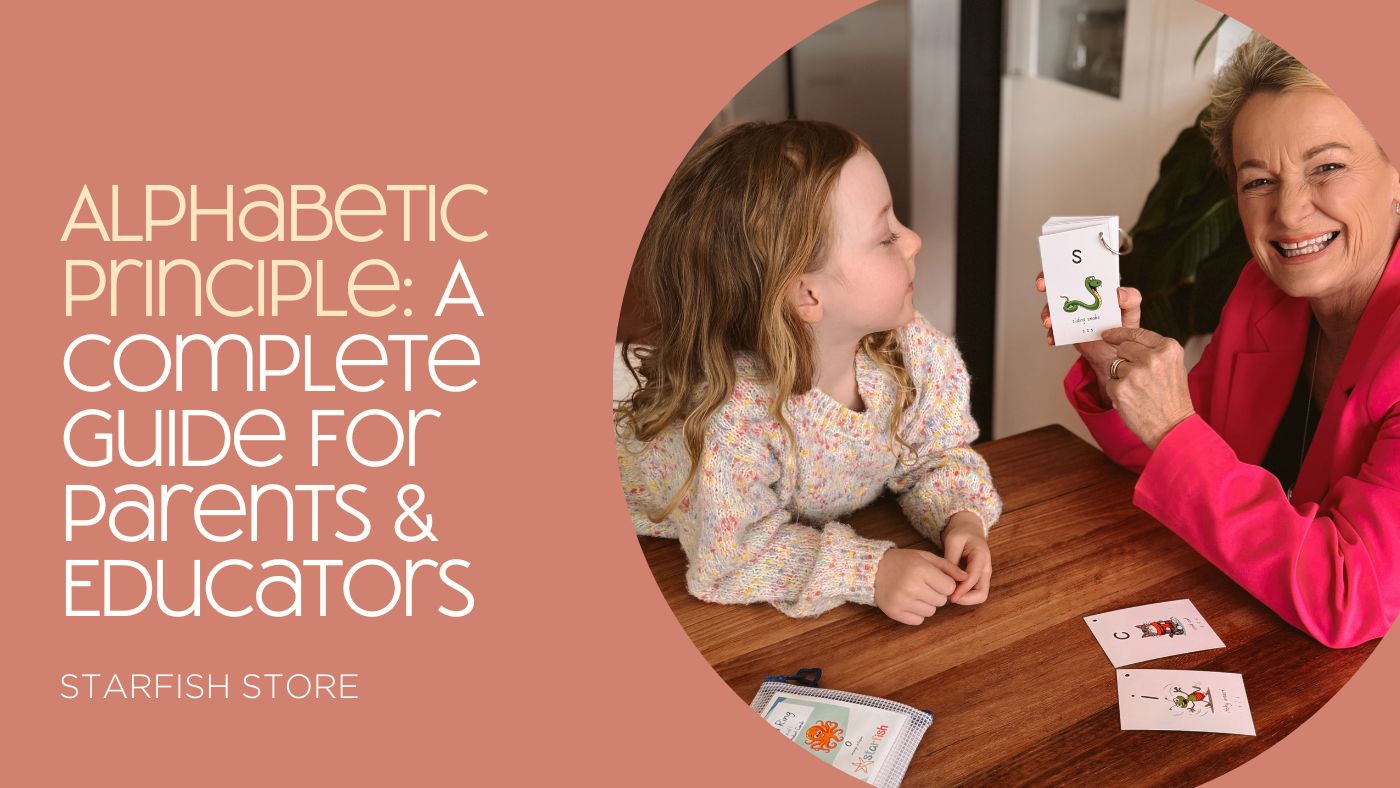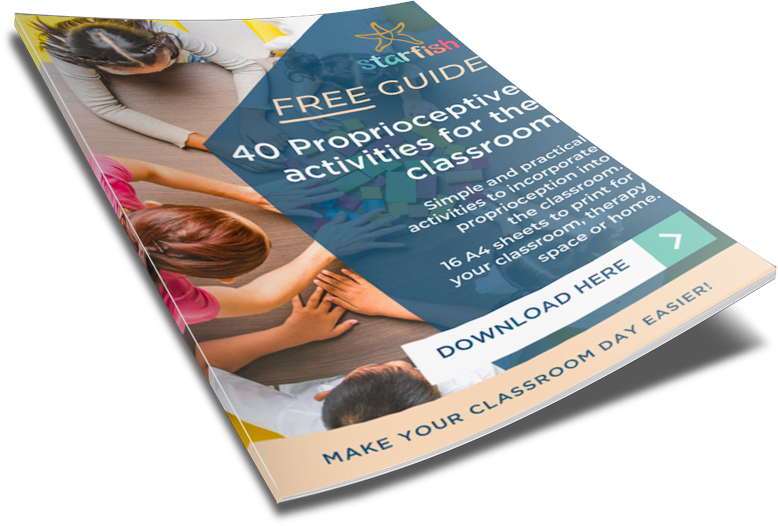Your Cart is Empty
Missed the shipping cut-off? Starfish Gift Cards are delivered instantly. → Shop Gift Cards
Missed the shipping cut-off? Starfish Gift Cards are delivered instantly. → Shop Gift Cards

The Alphabetic Principle is understanding that letters and letter combinations (graphemes) represent the sounds (phonemes) of spoken language. It’s the foundation of all phonics instruction — and ultimately, successful decoding and spelling.
It is not just learning the alphabet letter (name), it is knowing the sounds the letters represent.
Mastering the alphabetic principle is critical for learning to read and write. Understanding how letters represent sounds gives learners the ability to decode words and spell new ones - it unlocks the code for literacy.
How it links to Phonemic Awareness and Phonics:
Teaching the alphabetic principle begins with teaching the letter names and their sounds. This is known as letter–sound correspondence, and it is the building block of phonics, essential knowledge for being able to learn to decode and encode.
Some approaches to teaching the alphabet (and the alphabetic principle) are more helpful than others for beginners in the early stages of learning to read AND some letters of the alphabet represent multiple sounds. For example the letter ‘c’ represents a hard consonant sound as in “cat” or a soft consonant sound as in “city”.
Some letters of the alphabet represent multiple sounds. For example the letter ‘c’ represents a hard consonant sound as in “cat” or a soft consonant sound as in “city”.
In early literacy the focus should be on the most common sound a letter represents. A through to Z Sounds: Start with the most common sound for each letter.
For example:
b = /b/ as in bat
m = /m/ as in man
s = /s/ as in sun
The exception being the letter ‘y’ (where we initially teach the consonant sound even though the letter y is more commonly a vowel sound).
Click here for a link to our blog post on the 'tricky' letter y.
We teach the letter/sounds as the initial sound (phoneme) in a word. The exception being the letter ‘x’ (where we teach it as the final sound).
We also are careful to teach the pure sound. Many people mistakenly teach some letter sounds incorrectly, adding an “uh” (schwa) onto the consonant sound.
For example:
/b/ - correct b (short and crisp) incorrect buh
/m/ - correct m (extended mmm) incorrect muh
This matters because adding that “uh” can make it more difficult when blending sounds into words.
For example:
“buh-a-tuh” doesn’t sound like bat — but /b/ /a/ /t/ does.
Unfortunately many alphabet products, despite obviously targeting the pre-school age group, do NOT have the ideal letter-sound representations for beginners.
📌 Important: We teach the most common sound representation for each letter.
📌Important: We teach the pure sound — not a version with a “schwa” sound added.
Free Printable: A–Z Sound Chart Phonetically Correct Letter/Sounds for early literacy
To be sure you are teaching the correct sounds for each letter of the alphabet (for beginners, in early literacy) we’ve created a free downloadable Alphabet Sound Chart.
Most of us grew up learning the alphabet in alphabetical order — A through to Z. The alphabet song is widely known, easy to learn and many resources such as puzzles have the alphabet letters in alphabetic order.
Teaching letters in alphabetical order may seem logical, but it is not necessarily the optimal way to teach children when the goal is to facilitate the ease of learning to read and write.
This is because teaching the alphabet in order:
For example, after learning a, b, c, d, e there are minimal words a child would be able to read or spell.
We also no longer teach “one letter a week” in the first year of schooling, because we would be ¾ of the way through the year before children knew all the letters and (common) sound representations.
That’s not to say learning the alphabet song and alphabetical order are wrong. They can be fun, add variety and be helpful.
It makes far more sense to introduce the letter/sounds that based on the following principles:
Click here for a link to our blog post on what to teach when teaching the alphabet.
You will find literacy programs and school curriculum vary slightly in the sequence they follow when teaching the alphabet letter/sounds. Some may introduce common digraphs quite early (such as ck, sh, ch, th, ng). Slight differences in the sequence are not a deal breaker, if they generally follow the above principles.
Here’s one example of a well-structured teaching progression:
Set 1: s, a, t, p, i, n
Set 2: m, d, g, o
Set 3: c, k, e, u, r
Set 4: h, b, f, l
Set 5: j, v, w, x
Set 6: y, z, q
A widely used initial set across many good alphabet programs are - s, a, t, p, i, n.
Why these?
We recommend that you follow a sequence from a reputable literacy program, the Carnine order of teaching the alphabet or the department of education curriculum relevant to you.
Click here for a link to our blog alphabet sequence.
We also have a handy FREE download you can print at home or in the classroom—a list of the most common letters (in Carnine order) to support children learning the alphabet.
Caveat:
An exception to generally following a well structured sequence of teaching the alphabet, is adding in letters that are highly relevant to your child such as the letters in their name - even if they are supposedly “out of order”. Especially if your child expresses an interest in particular letters - if motivation is high, if something has a lot of meaning or purpose, it is far more likely that your child will engage and retain.
📌 Important: it is generally accepted that there is an order of teaching the alphabet that is optimal in early literacy.
Teaching the alphabet requires intentional, well-structured strategies that help children connect letters to sounds, remember them and name them - so they can be used when reading and writing. The following methods are evidence-based, engaging, and adaptable for all types of learners.
Explicit means we teach letters and sounds directly — not by assumption or osmosis. Systematic means we follow a planned, logical order that builds on previous learning.
How to Do It:


Flash cards can be a powerful tool when they do more than just show a letter. When paired with visuals, keywords (that link to the correct sound) and evenmotion, they activate multiple parts of the brain for stronger memory.
It can be difficult, initially, to remember individual letters (and sounds). Essentially, letters are meaningless squiggles on a page.
It is much easier to remember a letter and its sound when they are linked.
Key Features to Look For:
Other desirable features:

Rapid Serial Naming is the ability to quickly name a sequence of familiar items (like letters, colours, or objects). It’s one of the strongest predictors of reading fluency — the ability to read quickly, smoothly, and automatically.
Why It Matters:
How to Practise:
📌 Note: Just 2 minutes a day of RSN practice can significantly boost fluency over time.
Research suggests variation strengthens learning and the ability to generalise skills across contexts.
What This Means:




Why? Because it trains the brain to recognise the letter and its sound in any context, not just the one it was taught in.
Caveat: children with significant learning difficulties or intellectual disabilities will require significantly more practice using the consistent tools (such as our alphabet flash cards) BEFORE adding in variability.


Children learn best when they can see, hear, say, touch, and move — all at once. Multi-sensory letter–sound activities provides more concrete learning opportunities, engages different neural pathways, ensures variability and supports learning.
Try:
Using a variety of alphabet products will help maintain your child’s interest and also ensure “variability of instruction”. Having a variety of alphabet products will help maintain your child’s interest and also ensure “variability of instruction”.
Great alphabet products appeal to children, make learning fun AND are founded on both evidence and best practice (as described outlined previously).
Here are some our favourite alphabet products:
Excellent alphabet products appeal to children, make learning fun AND are founded on best practice.


The alphabetic principle is a gateway to reading success — it’s where the journey to confident, independent literacy begins. When children understand how letters link to sounds, they gain the key to decoding, spelling, and making sense of written language.
With clear strategies, the right tools, and a strong foundation in phonics, you can support children in becoming capable, joyful readers and writers. Whether you're a parent, educator, or tutor, your guidance can make all the difference.
If you would like to know more, don't hesitate to reach out. We are always here to help!
Kirstie Wishart M.Ed (Special Education).
Owner and founder of The Starfish Store. Kirstie’s professional life has included: teaching (in both public and private schools in Australia, New Zealand and Thailand), lecturer and subject coordinator at the University of Wollongong, Educational consultant (working with children and young people with a trauma background), OoHC Case Work Manager, and Specialist Tutor (working with children and young people with significant learning difficulties and/or disabilities).

40 Proprioceptive activities for the classroom. Simple and practical activities to incorporate Proprioceptive into the classroom. 16 A4 sheets to print for your classroom, therapy space or home.